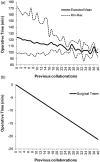The impact of team familiarity and surgical experience on operative efficiency: a retrospective analysis
- PMID: 27053357
- PMCID: PMC4827107
- DOI: 10.1177/0141076816634317
The impact of team familiarity and surgical experience on operative efficiency: a retrospective analysis
Abstract
Objectives: The independent impact of individual surgical experience and team familiarity on surgical performance has been widely studied; however, the interplay of these factors and their relative, quantified, contributions to performance is poorly understood. We determined the impact of team familiarity and surgeon, and cumulative team experience on operative efficiency in total knee replacement.
Design: Retrospective analysis of all total knee replacements conducted at the host institution in 1996-2009. Multivariate generalised-estimating-equation regression models were used to adjust for patient risk and clustering.
Setting: Tertiary care academic hospital.
Participants: All patients undergoing TKR at the host institution in 1996-2009.
Main outcome measure: Operative efficiency.
Results: A total of 4276 total knee replacements were completed by 1163 different surgical teams. The median experience level was 17.6 years for consultant surgeons and 3.7 years for trainee surgeons. After patient-risk adjustment, consultant surgical experience (p < 0.0001), trainee surgical experience (p < 0.05), cumulative team operative experience (p < 0.0001) and team familiarity (p < 0.0001) were associated with significant reductions in operative time. Surgical experience and team familiarity demonstrated concave and linear relationships with operative time, respectively. For a consultant surgeon, the expected reduction in operative time after 25 years in practice was 51 min, compared to a 21-min reduction over the span of 40 collaborations with the same team members.
Conclusions: Surgical experience and team familiarity display important and distinct relationships with operative time in total knee replacement. Appreciation of this interplay may serve to guide implementation and allocation of procedure-specific quality improvement strategies in surgery.
Keywords: Learning curve; collaboration; operative efficiency; performance curve; teamwork; total knee replacement.
© The Royal Society of Medicine.
Figures



References
-
- Duclos A, Carty MJ. Value of health care delivery. JAMA 2011; 306: 267–267. - PubMed
-
- www.nytimes.com/2012/02/12/sunday-review/big-datas-impact-in-the-world.html (last checked 26 April 2015).
-
- Carty MJ, Chan R, Huckman R, Snow D, Orgill DP. A detailed analysis of the reduction mammaplasty learning curve: a statistical process model for approaching surgical performance improvement. Plast Reconstr Surg 2009; 124: 706–714. - PubMed
-
- Edmondson ABRPG. Disrupted routines: team learning and new technology implementa-tion in hospitals. Admin Sci Quarter 2001; 46: 685–716.
-
- Mishra A, Catchpole K, Dale T, McCulloch P. The influence of non-technical performance on technical outcome in laparoscopic cholecystectomy. Surg Endosc 2008; 22: 68–73. - PubMed
MeSH terms
LinkOut - more resources
Full Text Sources
Other Literature Sources
Medical

